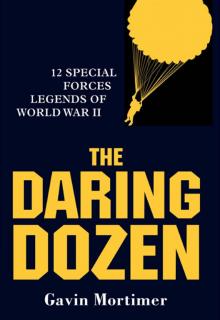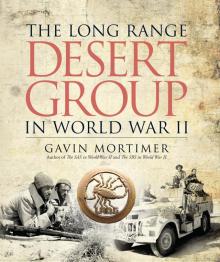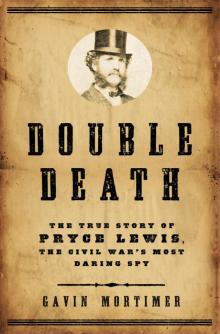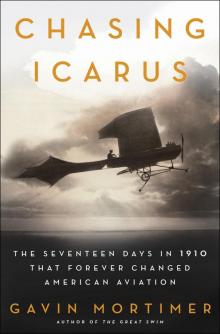- Home
- Gavin Mortimer
The Long Range Desert Group in World War II Page 7
The Long Range Desert Group in World War II Read online
Page 7
The ‘sweep to Benghazi’ referred to by the Times had brought the first phase of the war in North Africa to a conclusion. In two months General Richard O’Connor’s Western Desert Force (which subsequently became the Eighth Army) had advanced 500 miles and ‘beaten and destroyed an Italian army of four corps, comprising nine divisions and part of a tenth. It had captured 13,000 prisoners, 400 tanks and 1,290 guns, beside vast quantities of other material.’5 The Allies advanced west along the coast, seizing Bardia (4 January), Tobruk (22 January) and Benghazi (5–6 February). The enemy retreated to El Agheila, a bottleneck where they hoped to block an advance from Cyrenaica into Tripolitania (the western region of Libya). O’Connor wanted to press the attack and throw the Italians out of North Africa once and for all, but on 12 February Winston Churchill sent a telegram to Wavell, congratulating General Richard O’Connor’s Western Desert Force in capturing Benghazi ‘three weeks ahead of expectation’. Believing that their advances in North Africa were irreversible, Churchill instructed Wavell to transfer the bulk of his troops to Greece (under the command of Jumbo Wilson) in readiness for a German invasion. The Desert Air Force was removed almost entirely en masse, to the consternation of the Long Range Desert Group. ‘Our armoured division at Agheila was left with 40 obsolete tanks and 40 captured Italian tanks,’ commented Crichton-Stuart. ‘While the 11th Hussars had been relieved by another regiment in ancient Marmon Harrington armoured cars … shortage of armoured cars and anxiety about his southern flank led General Neame of CYRCOM [Land and Air Forces in Cyrenaica] to ask Middle East Headquarters for assistance from the LRDG in the middle of March 1941.’6
A plan was agreed whereby the Long Range Desert Group would operate in the El Agheila area, harassing the Italians to make them believe there was still a large-scale Allied presence in Cyrenaica. As for what Crichton-Stuart described as the ‘rumours and signs’ of the arrival of a significant German presence in North Africa, the British high command appeared blasé in the early spring of 1941. British complacency was soon to be punished. In the same week in February that Churchill cabled Wavell, instructing him to transfer the bulk of his troops to Greece, the vanguard of the Afrika Korps arrived in Libya.
When Adolf Hitler learned of Italy’s humiliation he was initially indifferent. North Africa was a sideshow, inconsequential in comparison to his ambitions in the Balkans and Russia. It was Grand Admiral Erich Raeder, head of the German navy, who did most to turn Hitler’s attention towards events in the region. What, Raeder asked of his Führer, would happen to Germany if the British maintained their iron grip on the Mediterranean? It would seriously jeopardize Hitler’s plans for conquest in the East. Nonetheless, it was with reluctance that on 11 January 1941 Hitler issued ‘Führer Directive No. 22’, authorizing the raising of a force to be sent to North Africa to support Germany’s Italian allies. Codenamed Operation Sunflower, the force was designated 5 Light Division, though it was not until 6 February that Hitler appointed Erwin Rommel as the unit commander, a dashing 49-year-old general who had led the 7th Panzer Division, ‘The Ghost Division’, during the invasion of the Low Countries the previous year.
The arrival in Libya in February 1941 of Rommel and his Afrika Korps presented a far greater challenge to the LRDG than the Italian army. (Author’s Collection)
In late February 1941 Rommel ordered the Afrika Korps to the front, augmenting their strength with a number of dummy tanks mounted on Volkswagens. The Germans dug in around the El Agheila bottleneck and, with just one squadron of RAF fighters ranged against them, the Luftwaffe controlled the sky in North Africa, exploiting their numerical advantage to prevent the British discovering how few troops they actually had on the ground. Other factors worked in Rommel’s favour: not only had the battle-hardened 6th Australian Division been sent to Greece, but the 7th Armoured Division was back in Egypt resting and refitting. Their replacements, the British 2nd Armoured Division and 9th Australian Division, were inexperienced and under-equipped and their commander, General Philip Neame, was callow in desert warfare compared to his predecessor, O’Connor.
By March the training of Y Patrol was complete, and so Bagnold paired them with G Patrol to form A Squadron under the command of Major Mitford, with an additional patrol, S, formed of soldiers from Southern Rhodesia. B Squadron consisted of two New Zealand patrols, T and R, after General Freyberg had relented and allowed the LRDG to continue employing his soldiers.
A Squadron was instructed to attack the Italians around El Agheila, while in early April Bagnold led B Squadron to Kufra to replace the Free French forces as garrison troops (the Sudan Defence Force had agreed to fulfil this role but they couldn’t arrive until July). Bagnold became in effect the king of Kufra, no easy reign given that three languages were spoken in the town and a similar number of currencies were in circulation. In an attempt to bring some kind of harmony to Kufra, Bagnold issued a proclamation ‘Under British Military Government’ upon arriving in the oasis. There were five articles in all, each one a series of dos and don’ts. He also promulgated a series of instructions to the LRDG to reduce the likelihood of any cultural misunderstandings. Entitled ‘Some Points on Conduct When Meeting the Arabs in the Desert’, it read:
Remove footwear upon entering their tents. Completely ignore their women. If thirsty drink the water they offer but DO NOT fill your waterbottle from their personal supply. Go to their well and fetch what you want … do not expect breakfast if you sleep the night. Arabs will give you a midday or evening meal.7
Each officer was also given a note in Arabic, to be handed to the natives if they ever found themselves lost in the desert. ‘To all Arab peoples – greetings and peace be upon you’, the note began. ‘The bearer of this letter is an officer of the British Government and a friend to all Arabs. Treat him well, guard him from harm, give him food and drink, help him to return to the nearest British soldiers and you will be rewarded. Peace and Mercy of God upon you.’8
The LRDG moved into Kufra following the Italian flight in March 1941 and here they are salvaging one of their enemy’s petrol pumps. (Courtesy of the SAS Regimental Archive)
The arrival in North Africa of Guy Prendergast eased some of the administrative pressure on Bagnold, and the tank officer quickly saw how best to develop the earlier experiment with aircraft as a means of supply and communication. Prendergast had learned to fly in the 1930s while serving in Sudan with the Western Arab Corps, purchasing a de Havilland Puss Moth and on one or two occasions flying it to England. The RAF had refused to loan any of their own aircraft to the LRDG so, recalled Prendergast, Bagnold ‘asked General Wavell if he would cough up enough money from Army funds for the LRDG to buy its own aircraft. To our surprise the answer was “yes”.’9 Prendergast ‘nosed about’ in Cairo’s Almaza airport and discovered two WACO aircraft that belonged to wealthy locals.† The RAF refused to help Prendergast find replacements so ‘I got my chaps to do a midnight raid on an army dump at Cairo, where I had spotted some crates containing new Continental engines for American [Sherman] with which the British army was equipped.’ Enquires were made, prices agreed and soon the LRDG were in possession of the two aircraft, having paid £3,000 for the pair. WACOs were biplanes whose names derived from the original American manufacturer, the Weaver Aircraft Company of Ohio. The more powerful of the two had a Jacobs 285hp engine and was nicknamed ‘Big Waco’, while ‘Small Waco’ possessed a Jacobs 225hp engine. Once Prendergast had recruited Trevor Barker, who had been taught to fly by the celebrated Australian aviator Charles Kingsford Smith, famed in 1928 for making the first transpacific flight from the USA to Australia, the pair familiarized themselves with the machine at Almaza. Prendergast then removed the back seats and installed a fold-up canvas seat so that wounded men could be transported and supplies carried.
It was the brainchild of Guy Prendergast, seen here unloading stores, to obtain two aircraft to maintain a link between Cairo and their remote desert bases in Kufra and Siwa. The man leaning on the wing is Trevor Barker, who
along with Prendergast piloted the WACOS. (Author’s Collection)
The crucial skill required was navigation, as Prendergast appreciated. ‘We had good compasses and drift indicators and I had taught myself how to find my position on the ground by means of position lines from shots of the sun taken by a sextant,’ he remembered. ‘We carried an RAF bubble sextant that we had “liberated” somehow and a yachtsman’s sextant with an artificial horizon.’10 They also carried a chronometer and tables, and most importantly one of the LRDG trained navigators. ‘Their job,’ explained Prendergast, ‘was to take accurate drift readings and plot our progress on a map, also to help with refuelling at our dumps and to help with the astro-nav if we had to land to fix our position.’11
Prendergast was punctilious to the point of obsession about logistics – one of the reasons Bagnold had been so eager to bring him to North Africa – and before the WACOs began traversing the desert, he sent out LRDG patrols to prepare a series of landing grounds on routes they would fly over. ‘These were stocked with petrol and every 15 miles on the route was a small dump of food and water in case we, or any patrol men who had their vehicles burnt up, should have to walk home,’ said Prendergast.
Prendergast took off on his inaugural flight in a WACO on 24 March, flying ‘as high as possible to get out of the bumpy air’. The aircraft reached maximum speeds of around 140mph and in a short space of time was providing a valuable link between Cairo and Kufra in the late spring of 1941.
Three Rhodesian soldiers, Scott, Massey and Kroeger, show off their tans at Kufra Oasis, which was captured from the Italians in March 1941. (Courtesy of the SAS Regimental Archive)
Garrisoning the oasis was not what Bagnold had in mind when he’d raised the LRDG nine months earlier, and patrolling was the only way to break the tedium. Even that distraction became scarce as petrol supplies began dwindling in April. The nearest petrol dump was in Wadi Halfa, 650 miles east, a journey that took the 10-ton lorries a week at best to make.
While B Squadron were stuck in Kufra, A Squadron under Captain Teddy Mitford, comprising G and Y Patrol, drove out of the Citadel on 25 March and turned west along the coast road, passing through Mersa Matruh and past Sidi Barrani, 80 miles west, where the previous December General O’Connor had captured 39,000 Italian prisoners in three days. They crossed into Libya at Fort Capuzzo and continued west through the ports of Bardia and Tobruk. No enemy was seen and the only casualty was Sergeant Jack Dennis, stung by a scorpion. Scorpions, like vipers, were an occupational hazard in the desert and the creatures would often seek out the soldiers at night for warmth. One officer in G patrol, Captain Alastair Timpson, recalled ‘getting out of my sleeping bag one morning when one of the black variety [of scorpions] popped out from under my chin and scuttled away’.12 In the Guards Patrol, ‘Pongo’ Reid held the record for scorpion stings – six, though none caused him much discomfort.
Once or twice desert cheetahs were spotted by the LRDG on patrol, but the creature that they detested the most was also the smallest. ‘The fly of Africa is intent on nosing its way into the eyes, ears and nose,’ recalled Timpson. ‘In swarms, as they were here, the flies were as powerfully obnoxious as Gulliver’s multitudes of Lilliputians, but far more evil. It was impossible for any man to be on sentry for more than half an hour without risk of his becoming unreliable, if not mad.’
‘In swarms, as they were here, the flies were as powerfully obnoxious as Gulliver’s multitudes of Lilliputians, but far more evil. It was impossible for any man to be on sentry for more than half an hour without risk of his becoming unreliable, if not mad.’
Alastair Timpson
When A Squadron reached Derna, they headed up into the Jebel [sometimes spelled Gebel] Akhdar, the ‘Green Mountains’. For the uninitiated, it was an extraordinary transformation, exchanging the hot, dusty desert roads for what Crichton-Stuart described as the Jebel’s ‘trees, lush grass and cattle’. On the other side of the Jebel the LRDG camped on the night of 30 March just outside CYRCOM headquarters at Barce. Mitford went into the town to report to General Neame, receiving instructions to reconnoitre Marada Oasis, approximately 250 miles south. Neame was concerned that German troops were planning to outflank the British position at Barce towards the end of April.
Mitford detailed Crichton-Stuart for the reconnaissance, and he left Barce early on 31 March with five trucks. The LRDG were no longer using the 30cwt Chevrolets, which were unfit for purpose after thousands of miles of tough desert travel. Unfortunately, it had not been possible to replace like with like, so Bagnold reluctantly took ownership of a consignment of Ford 30cwt four-wheel drive trucks. Seventy of these vehicles were given to the LRDG in February, and it took nearly a month of modification (notably camouflaging them in colours that included pink – effective because it blended in with the haze of the sun at dawn and dusk) before they were considered desert-worthy. Even then, Bagnold harboured doubts as to the Fords’ suitability because of ‘their greater weight … and the complications introduced by the front wheel drive’. Nearly all the men preferred the Chevrolets because they were easier to handle and because they had a bonnet. The Fords didn’t, and hot air from the engines was a constant irritation to the men on patrol.
As Crichton-Stuart and his patrol headed south, the going grew worse and ‘the heavier new trucks, sticking and grinding away despite their four-wheel drive, gave a lot of mechanical trouble’. The vehicles weren’t the only source of anxiety for the LRDG. On tuning into the BBC news on the evening of 1 April, Crichton-Stuart heard that ‘the enemy had broken through at Agheila and were approaching Agedabia’.13 Agedabia was south of Barce, effectively cutting Crichton-Stuart and his men off from Barce. Unfortunately, when he tried to contact CYRCOM on the radio he couldn’t get through, so Crichton-Stuart pressed on with his mission. ‘Each evening the operator tried in vain to contact the squadron, while the BBC news became ominously vaguer,’ he said.
As the five LRDG vehicles were swallowed by the vast dunes of the interior of the Libyan Desert, in their rear the British were retreating in the face of Rommel’s offensive, launched on 31 March. The German armour – many of the tanks Mark III and Mark IV Panzers – were far superior in firepower to the British Crusader tanks and the captured Italian M13 tanks that Neame’s men were also using. But what put the fear of God into the British armour more than any tank were the 88mm antiaircraft guns that could disable a tank from the distance of a mile.
By sundown on 1 April, the British had been pushed back in disarray and in the days that followed hundreds of their soldiers were captured as Rommel sent a battle-group ahead of his armour in a hook that entrapped the enemy east of Derna, close to the point where the coastal road rose into the Jebel Akhdar.
By now General O’Connor, still recuperating from a stomach ulcer, had arrived in the front line from Egypt. On the evening of 6 April, Neame, O’Connor and Brigadier John Combe, commanding the armoured cars of the 11th Hussars, got lost in the darkness on their way to their new battlefield HQ. They were eventually found, by the Germans.
Within a fortnight of launching his offensive Rommel had swept the British out of Cyrenaica, captured thousands of prisoners, and restored the confidence of his Italian ally. All that remained of the British in Libya was a small besieged garrison in the port of Tobruk, and Bagnold and B Squadron of the LRDG at Kufra, 500 miles south. Somewhere in between those points in early April was Crichton-Stuart and his small patrol.
A group of LRDG soldiers outside the mess room in Kufra Oasis in September1941. (Courtesy of the SAS Regimental Archive)
Rommel’s offensive had rendered their mission to reconnoitre Marada irrelevant, but it had taken until the late afternoon of 5 April before Crichton-Stuart’s signaller finally raised Mitford on the radio, which was a pre-war No.11 set that was carried by every patrol. The standard operational procedure for radio communication required the patrol’s signaller to contact the wireless room in the Citadel (in Cairo) at a specific time each evening. Since B
ritish signallers had replaced New Zealand ones in November 1940, they had been taught to imitate code messages sent between Egyptian inspectors of state wireless. This, recalled Lofty Carr, was because the ‘LRDG’s cover was as an Egyptian company … on the radio we used commercial procedure not military procedure, which is completely different, so that if Jerry was listening he would believe it was an Egyptian company and not us’.14
Mitford told Crichton-Stuart he was in Mekili and advised G Patrol to head to Jarabub, 215 miles to the east. The news dismayed Crichton-Stuart. ‘It was an ugly situation, for Mekili was the last stop before Tobruk, and it meant that not only it and Bardia were threatened, but also Jarabub and Siwa.’ G Patrol arrived at Jarabub on the morning of 10 April and were welcomed at the town’s fort by a ‘platoon of Senussi Arabs recruited in Egypt and commanded by a Frenchman’.15 Living up to the reputation of his countrymen, the French officer treated Crichton-Stuart’s patrol to a lavish meal, but towards its end the alarm was sounded. ‘Seizing our weapons we rushed to man the battlements in the best Western style and grimly covered a number of vehicles approaching from the north,’ recalled Crichton-Stuart. ‘The strength of my field glasses alone prevented internecine warfare, as just in time I identified the remainder of A Squadron.’
Mitford and his squadron, consisting of Y Patrol and the other half of G Patrol, were tired, grimy and hungry when they drove into Jarabub. Crichton-Stuart said the squadron ‘celebrated our reunion in Chianti’, before listening to an account of their operation.
They had left Barce on 1 April, heading south towards Msus, approximately 60 miles inland from the coast. The terrain was rough and progress slow, and along the way they strayed into a minefield. Captain Pat McCraith’s V8 car drove over one ordnance, leaving him with a broken arm, shattered teeth and a body pock-marked by shrapnel, and one of Y Patrol’s most effective operators, Anthony ‘Tich’ Cave was captured as the LRDG skirmished with the Italians on the outskirts of Mekili. Then at dawn on 8 April the Germans attacked the town in force from the south, east and north, and only the dexterous leadership of Mitford, allied to the dust storm, enabled the LRDG to withdraw without being detected. Mitford led his men towards the south-east, pausing at first light on 9 April to attack a column of German artillery at rest in a gully. ‘He hid us down behind a ridge and then moved us very cleverly off the ridge and we got behind a number of German artillery pieces with their backs and guns to us,’ recalled Lofty Carr.16 The LRDG moved noiselessly into position and on a hand signal from Mitford opened fire. ‘We obliterated these Germans,’ remembered Carr, ‘and then hopped it.’

 The Daring Dozen
The Daring Dozen The Long Range Desert Group in World War II
The Long Range Desert Group in World War II Double Death
Double Death Chasing Icarus
Chasing Icarus